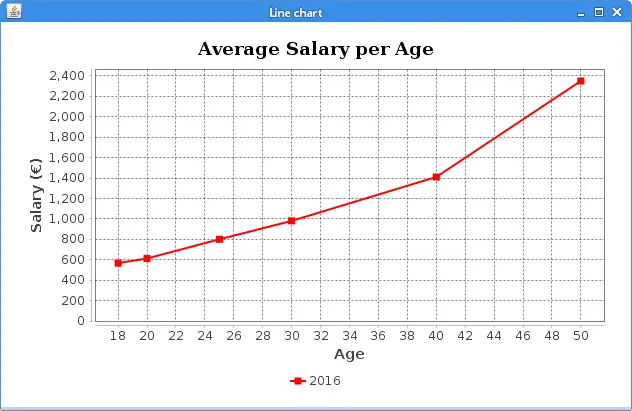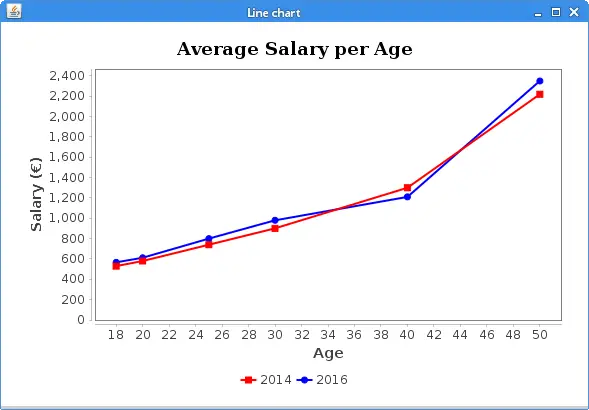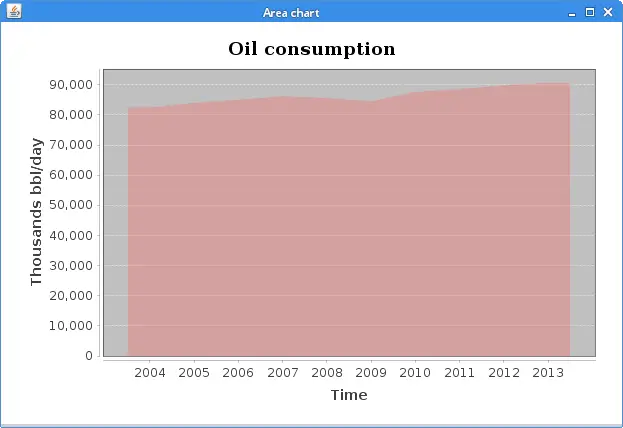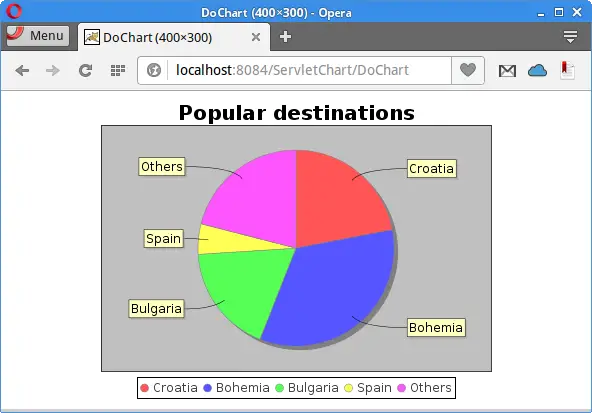JFreeChart
last modified January 27, 2024
In this article we learn how to use JFreeChart. We show how to create various types of charts. The charts are displayed in a Swing application and saved to an image file. We use a Java servlet to create and render a chart in a web browser and retrieve data for a chart from a MySQL database.
JFreeChart library
A chart is a drawing that shows information in a simple way, often using lines and curves to show amounts. JFreeChart is a popular Java library for creating charts. JFreeChart allows to create a wide variety of both interactive and non-interactive charts. We can create line charts, bar charts, area charts, scatter charts, pie charts, gantt charts and various specialized charts such as wind chart or bubble chart.
JFreeChart is extensively customizable; it allows to modify colours and paints of chart items, legends, styles of the lines or markers. It automatically draws the axis scales and legends. Charts have a built-in capability to zoom in with mouse. The existing charts can be easily updated through the listeners that the library has on its data collections. It supports multiple output formats including PNG, JPEG, PDF, and SVG.
JFreeChart was started by David Gilbert in 2000. Today, JFreeChart is the most widely used charting library among Java developers.
JFreeChart Maven dependency
<dependency>
<groupId>org.jfree</groupId>
<artifactId>jfreechart</artifactId>
<version>1.5.3</version>
</dependency>
For our projects we use this Maven dependency.
JFreeChart histogram
A histogram is an accurate representation of the distribution of numerical data. It is an estimate of the probability distribution of a continuous variable.
package com.zetcode;
import org.jfree.chart.ChartFactory;
import org.jfree.chart.ChartUtils;
import org.jfree.chart.JFreeChart;
import org.jfree.data.statistics.HistogramDataset;
import java.io.File;
import java.io.IOException;
public class HistogramEx {
public static void main(String[] args) throws IOException {
double[] vals = {
0.71477137, 0.55749811, 0.50809619, 0.47027228, 0.25281568,
0.66633175, 0.50676332, 0.6007552, 0.56892904, 0.49553407,
0.61093935, 0.65057417, 0.40095626, 0.45969447, 0.51087888,
0.52894806, 0.49397198, 0.4267163, 0.54091298, 0.34545257,
0.58548892, 0.3137885, 0.63521146, 0.57541744, 0.59862265,
0.66261386, 0.56744017, 0.42548488, 0.40841345, 0.47393027,
0.60882106, 0.45961208, 0.43371424, 0.40876484, 0.64367337,
0.54092033, 0.34240811, 0.44048106, 0.48874236, 0.68300902,
0.33563968, 0.58328107, 0.58054283, 0.64710522, 0.37801285,
0.36748982, 0.44386445, 0.47245989, 0.297599, 0.50295541,
0.39785732, 0.51370486, 0.46650358, 0.5623638, 0.4446957,
0.52949791, 0.54611411, 0.41020067, 0.61644868, 0.47493691,
0.50611458, 0.42518211, 0.45467712, 0.52438467, 0.724529,
0.59749142, 0.45940223, 0.53099928, 0.65159718, 0.38038268,
0.51639554, 0.41847437, 0.46022878, 0.57326103, 0.44913632,
0.61043611, 0.42694949, 0.43997814, 0.58787928, 0.36252603,
0.50937634, 0.47444256, 0.57992527, 0.29381335, 0.50357977,
0.42469464, 0.53049697, 0.7163579, 0.39741694, 0.41980533,
0.68091159, 0.69330702, 0.50518926, 0.55884098, 0.48618324,
0.48469854, 0.55342267, 0.67159111, 0.62352006, 0.34773486};
var dataset = new HistogramDataset();
dataset.addSeries("key", vals, 50);
JFreeChart histogram = ChartFactory.createHistogram("Normal distribution",
"y values", "x values", dataset);
ChartUtils.saveChartAsPNG(new File("histogram.png"), histogram, 450, 400);
}
}
In the example, we generate a histogram for a random distribution of values. The chart is generated into a PNG file and saved on the disk.
var dataset = new HistogramDataset();
dataset.addSeries("key", vals, 50);
Histogram chart displays values in a HistogramDataset.
The second argument of the addSeries method is the
array of double values. The third is the number of bins, i.e. the
number of rectangles drawn on the chart.
JFreeChart histogram = ChartFactory.createHistogram("Normal distribution",
"y values", "x values", dataset);
A histogram is created with the ChartFactory.createHistogram
method.
ChartUtils.saveChartAsPNG(new File("histogram.png"), histogram, 450, 400);
We write the chart to a PNG image with ChartUtils.saveChartAsPNG.
JFreeChart line chart
A line chart is a basic type of chart which displays information as a series of data points
connected by straight line segments. A line chart in JavaFX is created with
the ChartFactory.createXYLineChart.
package com.zetcode;
import org.jfree.chart.ChartFactory;
import org.jfree.chart.ChartPanel;
import org.jfree.chart.JFreeChart;
import org.jfree.chart.block.BlockBorder;
import org.jfree.chart.plot.PlotOrientation;
import org.jfree.chart.plot.XYPlot;
import org.jfree.chart.renderer.xy.XYLineAndShapeRenderer;
import org.jfree.chart.title.TextTitle;
import org.jfree.data.xy.XYDataset;
import org.jfree.data.xy.XYSeries;
import org.jfree.data.xy.XYSeriesCollection;
import javax.swing.BorderFactory;
import javax.swing.JFrame;
import java.awt.BasicStroke;
import java.awt.Color;
import java.awt.EventQueue;
import java.awt.Font;
public class LineChartEx extends JFrame {
public LineChartEx() {
initUI();
}
private void initUI() {
XYDataset dataset = createDataset();
JFreeChart chart = createChart(dataset);
ChartPanel chartPanel = new ChartPanel(chart);
chartPanel.setBorder(BorderFactory.createEmptyBorder(15, 15, 15, 15));
chartPanel.setBackground(Color.white);
add(chartPanel);
pack();
setTitle("Line chart");
setLocationRelativeTo(null);
setDefaultCloseOperation(JFrame.EXIT_ON_CLOSE);
}
private XYDataset createDataset() {
var series = new XYSeries("2016");
series.add(18, 567);
series.add(20, 612);
series.add(25, 800);
series.add(30, 980);
series.add(40, 1410);
series.add(50, 2350);
var dataset = new XYSeriesCollection();
dataset.addSeries(series);
return dataset;
}
private JFreeChart createChart(XYDataset dataset) {
JFreeChart chart = ChartFactory.createXYLineChart(
"Average salary per age",
"Age",
"Salary (€)",
dataset,
PlotOrientation.VERTICAL,
true,
true,
false
);
XYPlot plot = chart.getXYPlot();
var renderer = new XYLineAndShapeRenderer();
renderer.setSeriesPaint(0, Color.RED);
renderer.setSeriesStroke(0, new BasicStroke(2.0f));
plot.setRenderer(renderer);
plot.setBackgroundPaint(Color.white);
plot.setRangeGridlinesVisible(true);
plot.setRangeGridlinePaint(Color.BLACK);
plot.setDomainGridlinesVisible(true);
plot.setDomainGridlinePaint(Color.BLACK);
chart.getLegend().setFrame(BlockBorder.NONE);
chart.setTitle(new TextTitle("Average Salary per Age",
new Font("Serif", java.awt.Font.BOLD, 18)
)
);
return chart;
}
public static void main(String[] args) {
EventQueue.invokeLater(() -> {
var ex = new LineChartEx();
ex.setVisible(true);
});
}
}
In the example, we create a line chart showing average salary per age.
var series = new XYSeries("2016");
series.add(18, 567);
series.add(20, 612);
series.add(25, 800);
...
XYSeries represents a sequence of zero or more data items in the form (x, y).
var dataset = new XYSeriesCollection(); dataset.addSeries(series);
The series is added to the XYSeriesCollection, which is
a collection of XYSeries objects that can be used as a dataset.
JFreeChart chart = ChartFactory.createXYLineChart(
"Average salary per age",
"Age",
"Salary (€)",
dataset,
PlotOrientation.VERTICAL,
true,
true,
false
);
The ChartFactory.createXYLineChart creates a new line chart.
The parameters of the method are: chart title, X axis label, Y axis label,
data, plot orientation, and three flags indicating whether to show legend,
tooltips, and URLs.
XYPlot plot = chart.getXYPlot();
We get a reference to the plot in order to customize it.
var renderer = new XYLineAndShapeRenderer(); renderer.setSeriesPaint(0, Color.RED); renderer.setSeriesStroke(0, new BasicStroke(2.0f)); plot.setRenderer(renderer);
Here, we set a stroke and a colour for the line of the chart.
XYLineAndShapeRenderer is an object that connects
data points with lines and/or draws shapes at each data point.
The renderer is set with the setRenderer method.
plot.setBackgroundPaint(Color.white);
The setBackgroundPaint sets the background colour
of the plot area.
plot.setRangeGridlinesVisible(true); plot.setRangeGridlinePaint(Color.BLACK); plot.setDomainGridlinesVisible(true); plot.setDomainGridlinePaint(Color.BLACK);
We show the grid lines and paint them in black colour.
chart.getLegend().setFrame(BlockBorder.NONE);
We remove the border around the legend.
chart.setTitle(new TextTitle("Average Salary per Age",
new Font("Serif", java.awt.Font.BOLD, 18)
)
);
We create a chart title with a new font.

A line chart with two series
In the second example, we create a line chart having two data series.
package com.zetcode;
import org.jfree.chart.ChartFactory;
import org.jfree.chart.ChartPanel;
import org.jfree.chart.JFreeChart;
import org.jfree.chart.block.BlockBorder;
import org.jfree.chart.plot.PlotOrientation;
import org.jfree.chart.plot.XYPlot;
import org.jfree.chart.renderer.xy.XYLineAndShapeRenderer;
import org.jfree.chart.title.TextTitle;
import org.jfree.data.xy.XYDataset;
import org.jfree.data.xy.XYSeries;
import org.jfree.data.xy.XYSeriesCollection;
import javax.swing.BorderFactory;
import javax.swing.JFrame;
import java.awt.BasicStroke;
import java.awt.Color;
import java.awt.EventQueue;
import java.awt.Font;
public class LineChartEx2 extends JFrame {
public LineChartEx2() {
initUI();
}
private void initUI() {
XYDataset dataset = createDataset();
JFreeChart chart = createChart(dataset);
ChartPanel chartPanel = new ChartPanel(chart);
chartPanel.setBorder(BorderFactory.createEmptyBorder(15, 15, 15, 15));
chartPanel.setBackground(Color.white);
add(chartPanel);
pack();
setTitle("Line chart");
setLocationRelativeTo(null);
setDefaultCloseOperation(JFrame.EXIT_ON_CLOSE);
}
private XYDataset createDataset() {
var series1 = new XYSeries("2014");
series1.add(18, 530);
series1.add(20, 580);
series1.add(25, 740);
series1.add(30, 901);
series1.add(40, 1300);
series1.add(50, 2219);
var series2 = new XYSeries("2016");
series2.add(18, 567);
series2.add(20, 612);
series2.add(25, 800);
series2.add(30, 980);
series2.add(40, 1210);
series2.add(50, 2350);
var dataset = new XYSeriesCollection();
dataset.addSeries(series1);
dataset.addSeries(series2);
return dataset;
}
private JFreeChart createChart(final XYDataset dataset) {
JFreeChart chart = ChartFactory.createXYLineChart(
"Average salary per age",
"Age",
"Salary (€)",
dataset,
PlotOrientation.VERTICAL,
true,
true,
false
);
XYPlot plot = chart.getXYPlot();
var renderer = new XYLineAndShapeRenderer();
renderer.setSeriesPaint(0, Color.RED);
renderer.setSeriesStroke(0, new BasicStroke(2.0f));
renderer.setSeriesPaint(1, Color.BLUE);
renderer.setSeriesStroke(1, new BasicStroke(2.0f));
plot.setRenderer(renderer);
plot.setBackgroundPaint(Color.white);
plot.setRangeGridlinesVisible(false);
plot.setDomainGridlinesVisible(false);
chart.getLegend().setFrame(BlockBorder.NONE);
chart.setTitle(new TextTitle("Average Salary per Age",
new Font("Serif", Font.BOLD, 18)
)
);
return chart;
}
public static void main(String[] args) {
EventQueue.invokeLater(() -> {
var ex = new LineChartEx2();
ex.setVisible(true);
});
}
}
The example draws a line chart with two data series.
var series1 = new XYSeries("2014");
series1.add(18, 530);
series1.add(20, 580);
series1.add(25, 740);
...
We create the first series; it contains data for 2014.
var series2 = new XYSeries("2016");
series2.add(18, 567);
series2.add(20, 612);
series2.add(25, 800);
...
A second data series is created; it contains data for 2016.
var dataset = new XYSeriesCollection(); dataset.addSeries(series1); dataset.addSeries(series2);
The series are added to the XYSeriesCollection with the
addSeries method.
renderer.setSeriesPaint(0, Color.RED); renderer.setSeriesStroke(0, new BasicStroke(2.0f)); renderer.setSeriesPaint(1, Color.BLUE); renderer.setSeriesStroke(1, new BasicStroke(2.0f));
One line is painted in red colour and one in blue.
plot.setRangeGridlinesVisible(false); plot.setDomainGridlinesVisible(false);
The grid lines are turned off.

Saving line chart to image
ChartUtils is a collection of utility methods for JFreeChart.
It includes methods for converting charts to image formats and creating simple HTML
image maps.
package com.zetcode;
import java.io.File;
import java.io.IOException;
import org.jfree.chart.ChartFactory;
import org.jfree.chart.ChartUtils;
import org.jfree.chart.JFreeChart;
import org.jfree.chart.plot.PlotOrientation;
import org.jfree.data.xy.XYSeries;
import org.jfree.data.xy.XYSeriesCollection;
public class LineChartToPNGEx {
public static void main(String[] args) throws IOException {
var series1 = new XYSeries("2014");
series1.add(18, 530);
series1.add(20, 580);
series1.add(25, 740);
series1.add(30, 901);
series1.add(40, 1300);
series1.add(50, 2219);
var dataset = new XYSeriesCollection();
dataset.addSeries(series1);
JFreeChart chart = ChartFactory.createXYLineChart(
"Average salary per age",
"Age",
"Salary (€)",
dataset,
PlotOrientation.VERTICAL,
true,
true,
false
);
ChartUtils.saveChartAsPNG(new File("line_chart.png"), chart, 450, 400);
}
}
The example creates a line chart and saves it into a PNG file.
ChartUtils.saveChartAsPNG(new File("line_chart.png"), chart, 450, 400);
The ChartUtils.saveChartAsPNG saves a chart to the specified file
in PNG format.
JFreeChart bubble chart
Bubble chart is a variation of a scatter chart with an additional dimension. Instead of data points, we use with bubbles. The first two dimensions are visualized as coordinates. The size of the bubbles represents the additional dimension.
A bubble chart is created with ChartFactory.createBubbleChart
method in JFreeChart.
package com.zetcode;
import org.jfree.chart.ChartFactory;
import org.jfree.chart.ChartPanel;
import org.jfree.chart.JFreeChart;
import org.jfree.chart.axis.NumberAxis;
import org.jfree.chart.plot.PlotOrientation;
import org.jfree.chart.plot.XYPlot;
import org.jfree.chart.renderer.xy.XYBubbleRenderer;
import org.jfree.chart.title.TextTitle;
import org.jfree.data.xy.DefaultXYZDataset;
import org.jfree.data.xy.XYZDataset;
import javax.swing.BorderFactory;
import javax.swing.JFrame;
import java.awt.Color;
import java.awt.EventQueue;
import java.awt.Font;
public class BubbleChartEx extends JFrame {
public BubbleChartEx() {
initUI();
}
private void initUI() {
XYZDataset dataset = createDataset();
JFreeChart chart = createChart(dataset);
ChartPanel chartPanel = new ChartPanel(chart);
chartPanel.setBorder(BorderFactory.createEmptyBorder(15, 15, 15, 15));
chartPanel.setBackground(Color.white);
add(chartPanel);
pack();
setTitle("Bubble chart");
setLocationRelativeTo(null);
setDefaultCloseOperation(JFrame.EXIT_ON_CLOSE);
}
private XYZDataset createDataset() {
var dataset = new DefaultXYZDataset();
dataset.addSeries("Product A", new double[][]{{50}, {642}, {23 * 5}});
dataset.addSeries("Product B", new double[][]{{23}, {540}, {47 * 5}});
dataset.addSeries("Product C", new double[][]{{19}, {188}, {30 * 5}});
return dataset;
}
private JFreeChart createChart(XYZDataset dataset) {
JFreeChart chart = ChartFactory.createBubbleChart(
"Products",
"Quantity",
"Price",
dataset,
PlotOrientation.VERTICAL,
true,
true,
false);
XYPlot plot = (XYPlot) chart.getPlot();
NumberAxis nax1 = (NumberAxis) plot.getDomainAxis();
nax1.setLowerMargin(0.2);
nax1.setUpperMargin(0.2);
NumberAxis nax2 = (NumberAxis) plot.getRangeAxis();
nax2.setLowerMargin(0.9);
nax2.setUpperMargin(0.9);
XYBubbleRenderer renderer = (XYBubbleRenderer) plot.getRenderer();
renderer.setDefaultItemLabelsVisible(true);
chart.setTitle(new TextTitle("Products",
new Font("Serif", java.awt.Font.BOLD, 18))
);
return chart;
}
public static void main(String[] args) {
EventQueue.invokeLater(() -> {
var ex = new BubbleChartEx();
ex.setVisible(true);
});
}
}
We have three products. With these products, we have their quantities, prices, and market shares. The quantities are placed on the x-axis and the prices on the y-axis. The market share values are z-values; they are represented by the bubbles.
private XYZDataset createDataset() {
var dataset = new DefaultXYZDataset();
dataset.addSeries("Product A", new double[][]{{50}, {642}, {23 * 5}});
dataset.addSeries("Product B", new double[][]{{23}, {540}, {47 * 5}});
dataset.addSeries("Product C", new double[][]{{19}, {188}, {30 * 5}});
return dataset;
}
The bubble chart uses the XYZDataset. The z-values (market share)
is adjusted; we make the circles larger.
JFreeChart chart = ChartFactory.createBubbleChart(
"Products",
"Quantity",
"Price",
dataset,
PlotOrientation.VERTICAL,
true,
true,
false);
We create the chart with ChartFactory.createBubbleChart.
NumberAxis nax1 = (NumberAxis) plot.getDomainAxis();
nax1.setLowerMargin(0.2);
nax1.setUpperMargin(0.2);
NumberAxis nax2 = (NumberAxis) plot.getRangeAxis();
nax2.setLowerMargin(0.9);
nax2.setUpperMargin(0.9);
We adjust the values on the axes so that all bubbles are visible.
JFreeChart area chart
An area chart displays graphically quantitative data that change over time.
An area chart is created with ChartFactory.createAreaChart method
in JFreeChart.
package com.zetcode;
import org.jfree.chart.ChartFactory;
import org.jfree.chart.ChartPanel;
import org.jfree.chart.JFreeChart;
import org.jfree.chart.plot.CategoryPlot;
import org.jfree.chart.plot.PlotOrientation;
import org.jfree.chart.renderer.AreaRendererEndType;
import org.jfree.chart.renderer.category.AreaRenderer;
import org.jfree.chart.title.TextTitle;
import org.jfree.data.category.CategoryDataset;
import org.jfree.data.general.DatasetUtils;
import javax.swing.BorderFactory;
import javax.swing.JFrame;
import java.awt.Color;
import java.awt.EventQueue;
import java.awt.Font;
public class AreaChartEx extends JFrame {
public AreaChartEx() {
initUI();
}
private void initUI() {
CategoryDataset dataset = createDataset();
JFreeChart chart = createChart(dataset);
ChartPanel chartPanel = new ChartPanel(chart);
chartPanel.setBorder(BorderFactory.createEmptyBorder(15, 15, 15, 15));
chartPanel.setBackground(Color.white);
add(chartPanel);
pack();
setTitle("Area chart");
setLocationRelativeTo(null);
setDefaultCloseOperation(JFrame.EXIT_ON_CLOSE);
}
private CategoryDataset createDataset() {
double[][] data = new double[][]{
{82502, 84026, 85007, 86216, 85559, 84491, 87672,
88575, 89837, 90701}
};
CategoryDataset dataset = DatasetUtils.createCategoryDataset(
new String[]{"Oil"}, new String[]{"2004", "2005", "2006",
"2007", "2008", "2009", "2010", "2011", "2012", "2013"},
data
);
return dataset;
}
private JFreeChart createChart(CategoryDataset dataset) {
JFreeChart chart = ChartFactory.createAreaChart(
"Oil consumption",
"Time",
"Thousands bbl/day",
dataset,
PlotOrientation.VERTICAL,
false,
true,
true
);
CategoryPlot plot = (CategoryPlot) chart.getPlot();
plot.setForegroundAlpha(0.3f);
AreaRenderer renderer = (AreaRenderer) plot.getRenderer();
renderer.setEndType(AreaRendererEndType.LEVEL);
chart.setTitle(new TextTitle("Oil consumption",
new Font("Serif", java.awt.Font.BOLD, 18))
);
return chart;
}
public static void main(String[] args) {
EventQueue.invokeLater(() -> {
var ex = new AreaChartEx();
ex.setVisible(true);
});
}
}
The example shows an area chart showing world crude oil consumption by year.
double[][] data = new double[][]{
{82502, 84026, 85007, 86216, 85559, 84491, 87672,
88575, 89837, 90701}
};
CategoryDataset dataset = DatasetUtils.createCategoryDataset(
new String[]{"Oil"}, new String[]{"2004", "2005", "2006",
"2007", "2008", "2009", "2010", "2011", "2012", "2013"},
data
);
A dataset is created with the DatasetUtils.createCategoryDataset
method. A category dataset values associated with categories. In our examples, we
have years associated with oil consumption.
CategoryPlot plot = (CategoryPlot) chart.getPlot(); plot.setForegroundAlpha(0.3f);
We mave the chart transparent with the setForegroundAlpha method.
AreaRenderer renderer = (AreaRenderer) plot.getRenderer(); renderer.setEndType(AreaRendererEndType.LEVEL);
We adjust the endings of the chart.

JFreeChart bar chart
A bar chart presents grouped data with rectangular bars with lengths proportional to the values that they represent. The bars can be plotted vertically or horizontally.
package com.zetcode;
import org.jfree.chart.ChartFactory;
import org.jfree.chart.ChartPanel;
import org.jfree.chart.JFreeChart;
import org.jfree.chart.plot.PlotOrientation;
import org.jfree.data.category.CategoryDataset;
import org.jfree.data.category.DefaultCategoryDataset;
import javax.swing.BorderFactory;
import javax.swing.JFrame;
import java.awt.Color;
import java.awt.EventQueue;
public class BarChartEx extends JFrame {
public BarChartEx() {
initUI();
}
private void initUI() {
CategoryDataset dataset = createDataset();
JFreeChart chart = createChart(dataset);
ChartPanel chartPanel = new ChartPanel(chart);
chartPanel.setBorder(BorderFactory.createEmptyBorder(15, 15, 15, 15));
chartPanel.setBackground(Color.white);
add(chartPanel);
pack();
setTitle("Bar chart");
setLocationRelativeTo(null);
setDefaultCloseOperation(JFrame.EXIT_ON_CLOSE);
}
private CategoryDataset createDataset() {
var dataset = new DefaultCategoryDataset();
dataset.setValue(46, "Gold medals", "USA");
dataset.setValue(38, "Gold medals", "China");
dataset.setValue(29, "Gold medals", "UK");
dataset.setValue(22, "Gold medals", "Russia");
dataset.setValue(13, "Gold medals", "South Korea");
dataset.setValue(11, "Gold medals", "Germany");
return dataset;
}
private JFreeChart createChart(CategoryDataset dataset) {
JFreeChart barChart = ChartFactory.createBarChart(
"Olympic gold medals in London",
"",
"Gold medals",
dataset,
PlotOrientation.VERTICAL,
false, true, false);
return barChart;
}
public static void main(String[] args) {
EventQueue.invokeLater(() -> {
var ex = new BarChartEx();
ex.setVisible(true);
});
}
}
The code example uses a bar chart to show the number of Olympic gold medals per country in London 2012.
var dataset = new DefaultCategoryDataset(); dataset.setValue(46, "Gold medals", "USA"); dataset.setValue(38, "Gold medals", "China"); dataset.setValue(29, "Gold medals", "UK"); dataset.setValue(22, "Gold medals", "Russia"); dataset.setValue(13, "Gold medals", "South Korea"); dataset.setValue(11, "Gold medals", "Germany");
We use a DefaultCategoryDataset to create a dataset.
JFreeChart barChart = ChartFactory.createBarChart(
"Olympic gold medals in London",
"",
"Gold medals",
dataset,
PlotOrientation.VERTICAL,
false, true, false);
A bar chart is created with the ChartFactory.createBarChart
method.

JFreeChart pie chart
A pie chart is a circular chart which is divided into slices to illustrate
numerical proportion. A pie chart is created with the
ChartFactory.createPieChart method in JFreeChart.
package com.zetcode;
import org.jfree.chart.ChartFactory;
import org.jfree.chart.ChartPanel;
import org.jfree.chart.JFreeChart;
import org.jfree.data.general.DefaultPieDataset;
import javax.swing.BorderFactory;
import javax.swing.JFrame;
import java.awt.Color;
import java.awt.EventQueue;
public class PieChartEx extends JFrame {
public PieChartEx() {
initUI();
}
private void initUI() {
DefaultPieDataset dataset = createDataset();
JFreeChart chart = createChart(dataset);
ChartPanel chartPanel = new ChartPanel(chart);
chartPanel.setBorder(BorderFactory.createEmptyBorder(15, 15, 15, 15));
chartPanel.setBackground(Color.white);
add(chartPanel);
pack();
setTitle("Pie chart");
setLocationRelativeTo(null);
setDefaultCloseOperation(JFrame.EXIT_ON_CLOSE);
}
private DefaultPieDataset createDataset() {
var dataset = new DefaultPieDataset();
dataset.setValue("Apache", 52);
dataset.setValue("Nginx", 31);
dataset.setValue("IIS", 12);
dataset.setValue("LiteSpeed", 2);
dataset.setValue("Google server", 1);
dataset.setValue("Others", 2);
return dataset;
}
private JFreeChart createChart(DefaultPieDataset dataset) {
JFreeChart pieChart = ChartFactory.createPieChart(
"Web servers market share",
dataset,
false, true, false);
return pieChart;
}
public static void main(String[] args) {
EventQueue.invokeLater(() -> {
var ex = new PieChartEx();
ex.setVisible(true);
});
}
}
The example uses a pie chart to show the market share of web servers.
var dataset = new DefaultPieDataset();
dataset.setValue("Apache", 52);
dataset.setValue("Nginx", 31);
dataset.setValue("IIS", 12);
...
A DefaultPieDataset is used to create a dataset.
JFreeChart barChart = ChartFactory.createPieChart(
"Web servers market share",
dataset,
false, true, false);
A new pie chart is created with the ChartFactory.createPieChart method.
JFreeChart in a servlet
In the following example, we use a Java servlet to create a pie chart. The chart is rendered in a web browser.
package com.zetcode.web;
import org.jfree.chart.ChartFactory;
import org.jfree.chart.ChartUtils;
import org.jfree.chart.JFreeChart;
import org.jfree.data.general.DefaultPieDataset;
import javax.servlet.annotation.WebServlet;
import javax.servlet.http.HttpServlet;
import javax.servlet.http.HttpServletRequest;
import javax.servlet.http.HttpServletResponse;
import java.io.IOException;
import java.io.OutputStream;
@WebServlet(name = "DoChart", urlPatterns = {"/DoChart"})
public class DoChart extends HttpServlet {
@Override
protected void doGet(HttpServletRequest request, HttpServletResponse response)
throws IOException {
response.setContentType("image/png");
OutputStream outputStream = response.getOutputStream();
JFreeChart chart = getChart();
int width = 500;
int height = 350;
ChartUtils.writeChartAsPNG(outputStream, chart, width, height);
}
public JFreeChart getChart() {
var dataset = new DefaultPieDataset();
dataset.setValue("Croatia", 22);
dataset.setValue("Bohemia", 34);
dataset.setValue("Bulgaria", 18);
dataset.setValue("Spain", 5);
dataset.setValue("Others", 21);
JFreeChart chart = ChartFactory.createPieChart("Popular destinations",
dataset, true, false, false);
chart.setBorderVisible(false);
return chart;
}
}
The DoChart servlet creates a pie chart and sends
it to the client.
response.setContentType("image/png");
The setContentType sets the content to a PNG image.
OutputStream outputStream = response.getOutputStream();
With the getOutputStream method we get an output stream.
It is a tunnel to which we send the data.
ChartUtils.writeChartAsPNG(outputStream, chart, width, height);
The ChartUtils.writeChartAsPNG writes the binary data
to the outputstrem.

Showing data from a MySQL database
JDBCCategoryDataset is a CategoryDataset
implementation over a database JDBC result set. The dataset is populated
via a call to executeQuery with the string SQL query.
DROP TABLE IF EXISTS GoldMedalsLondon; CREATE TABLE GoldMedalsLondon ( Id int(11) NOT NULL AUTO_INCREMENT, Country text, Medals int(11) DEFAULT NULL, PRIMARY KEY (Id) ) ENGINE=InnoDB AUTO_INCREMENT=7 DEFAULT CHARSET=latin1; LOCK TABLES GoldMedalsLondon WRITE; INSERT INTO GoldMedalsLondon VALUES (1,'USA',46),(2,'China',38),(3,'UK',29), (4,'Russia',22),(5,'South Korea',13),(6,'Germany',11); UNLOCK TABLES;
We have this data in a MySQL database table.
mysql> SELECT * FROM GoldMedalsLondon; +----+-------------+--------+ | Id | Country | Medals | +----+-------------+--------+ | 1 | USA | 46 | | 2 | China | 38 | | 3 | UK | 29 | | 4 | Russia | 22 | | 5 | South Korea | 13 | | 6 | Germany | 11 | +----+-------------+--------+ 6 rows in set (0.00 sec)
We show the data with the mysql tool.
package com.zetcode;
import org.jfree.chart.ChartFactory;
import org.jfree.chart.ChartUtils;
import org.jfree.chart.JFreeChart;
import org.jfree.chart.plot.PlotOrientation;
import org.jfree.data.jdbc.JDBCCategoryDataset;
import java.io.File;
import java.io.IOException;
import java.sql.Connection;
import java.sql.DriverManager;
import java.sql.SQLException;
public class MySQLChartEx {
private static JDBCCategoryDataset dataset;
public static void main(String[] args) throws IOException, SQLException {
String url = "jdbc:mysql://localhost:3306/testdb";
String user = "root";
String password = "s$cret";
try (Connection con = DriverManager.getConnection(url, user, password)) {
dataset = new JDBCCategoryDataset(con);
dataset.executeQuery("SELECT Country, Medals FROM GoldMedalsLondon");
}
JFreeChart barChart = ChartFactory.createBarChart(
"Olympic Gold medals in London",
"",
"Gold medals",
dataset,
PlotOrientation.VERTICAL,
false, true, false);
ChartUtils.saveChartAsPNG(new File("medals.png"), barChart, 450, 400);
}
}
The example retrieves data from a MySQL table, creates a bar chart, and saves it into a PNG image.
try (Connection con = DriverManager.getConnection(url, user, password)) {
dataset = new JDBCCategoryDataset(con);
dataset.executeQuery("SELECT Country, Medals FROM GoldMedalsLondon");
}
JDBCCategoryDataset is created; it takes a database connection as a parameter.
dataset.executeQuery("SELECT Country, Medals FROM GoldMedalsLondon");
The executeQuery populates the dataset by executing the supplied query
against the existing database connection. The SQL query must return at least two columns.
The first column is the category name and remaining columns are values.
JFreeChart barChart = ChartFactory.createBarChart(
"Olympic Gold medals in London",
"",
"Gold medals",
dataset,
PlotOrientation.VERTICAL,
false, true, false);
The bar chart is created.
ChartUtils.saveChartAsPNG(new File("medals.png"), barChart, 450, 400);\
The bar chart is saved to a PNG file with the ChartUtils.saveChartAsPNG
method.
Source
In this article we have created some basic charts in Java using JFreeChart.
Author
List all Java tutorials.